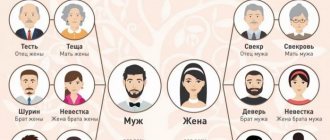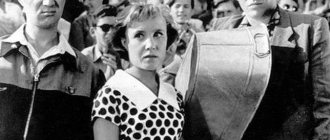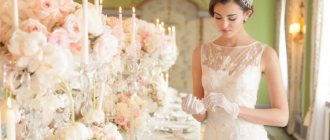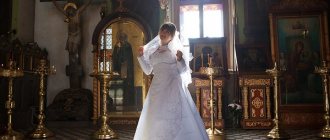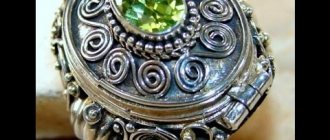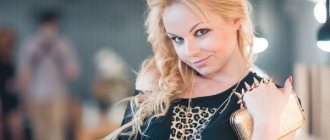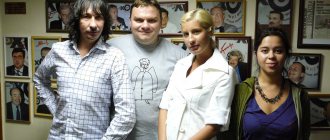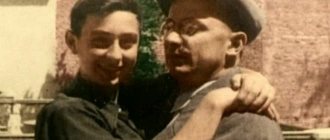Biography of Nikita Khrushchev
Nikita Sergeevich Khrushchev is one of the most impulsive and controversial Soviet political leaders. He expanded the boundaries of freedom and earned a reputation as a fighter for democratization, condemning Stalin's terror, amnestying political prisoners, reducing repression and the influence of ideological censorship. Under him, a breakthrough into space was made and large-scale housing construction was launched, collective farmers got passports and an unprecedented openness to the world with the arrival of foreign tourists, artists, and students.
In the photo: Nikita Sergeevich Khrushchev
But the name of the third head of the USSR (after Lenin and Stalin) is also associated with the suppression of the uprising against the pro-Soviet regime in Hungary, the shooting of protest participants in the former capital of the Don Army Novocherkassk, death sentences by courts for thieves of public property and black marketeers, the failed corn epic, the persecution of Nobel laureate Boris Pasternak, obscene language in the Manege at an exhibition of avant-garde artists, the breakdown of relations with China, the peak of Cold War tension with the United States.
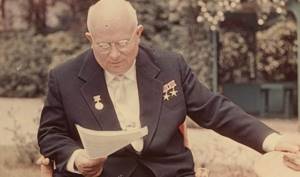
Nikita Khrushchev - the third head of the USSR
The politician, who sought to build a better life for the people, but did not have deep encyclopedic knowledge and high culture (the old Bolsheviks called him “an ignoramus and a buffoon”), made a significant contribution to undermining the authority of Marxist philosophy in the world. “The first freak of the Soviet Union,” - this is the nickname Khrushchev earned from the mouths of our contemporaries.
Caribbean crisis
The intensity of relations between the USSR and the USA continued to bring the world to the brink of nuclear disaster. The first serious aggravation occurred in 1958 after Khrushchev’s proposal to West Germany to change its own status and create a demilitarized zone within itself. This proposal was rejected, which caused a deterioration in relations between the superpowers.
Khrushchev also sought to support uprisings and popular discontent in those regions of the world where the United States enjoyed great influence. At the same time, the States themselves in every possible way strengthened pro-American governments around the world and economically helped their allies.
In addition, the Soviet Union developed intercontinental ballistic weapons. This could not but cause concern in the United States. At the same time, in 1961, the Second Berlin Crisis began to flare up. The leadership of West Germany began to create a wall separating the GDR from the Federal Republic of Germany. This step displeased Khrushchev and the entire Soviet leadership.
However, the most dangerous moment in relations between the USSR and the USA was the Cuban Missile Crisis. After Khrushchev’s shocking decision to the West to create a nuclear fist in Cuba directed against the United States, the world for the first time in history found itself literally on the brink of destruction. Of course, it was Khrushchev who provoked the United States to retaliate. His historical portrait, however, is replete with such ambiguous decisions, which fit well into the general behavior of the First Secretary of the Central Committee. The culmination of events occurred on the night of October 27-28, 1962. Both powers were ready to launch a pre-emptive nuclear strike on each other. However, both Khrushchev and the then US President Kennedy understood that a nuclear war would leave behind neither winners nor losers. To the relief of the whole world, prudence of both leaders prevailed.
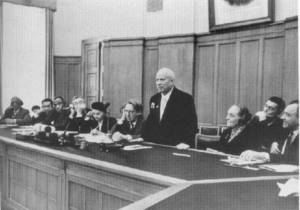
Childhood
The future extraordinary party leader was born on April 15, 1894 in the village of Kalinovka, located 170 km from Kursk. He became the first-born in the peasant family of Sergei Nikanorovich (died 1938 from tuberculosis) and Ksenia Ivanovna (1872 - 1945) Khrushchev. Later they had a daughter, Irina.
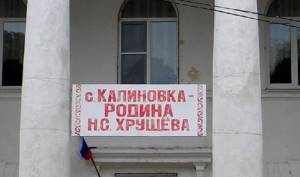
Kalinovka village - the birthplace of Nikita Khrushchev
They worked tirelessly, but lived poorly. The boy received his primary education at a parochial school. At the age of 9, when he learned to count to thirty, his father decided that he had had enough of learning (“You’ll never have more than 30 rubles anyway,” his father told him), and sent him to work as a farm laborer for a landowner.
In the 1900s, their family went to work in Yuzovka (now Donetsk, Ukraine). They lived in a barracks in a workers’ village, where (according to his recollections) “dirt, crime and stench” reigned; they slept on two-tier bunks in rooms of 60-70 people. His father worked as a miner, his mother as a laundress, and Nikita as a steam boiler cleaner. The parents dreamed of saving money to buy a horse and return to the village, but they never succeeded.
According to the recollections of family friends, Ksenia Ivanovna considered her husband a doormat all her life and kept him under her thumb. She herself was a fighting woman, with character, while Sergei Nikanorovich was described as a kind man, but spineless.
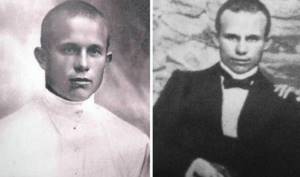
Nikita Khrushchev in his youth
Nikita Sergeevich once told his son-in-law that when he was little and grazing cows in a meadow, an unfamiliar old woman approached him and said: “Boy, a great future awaits you.” Little Nikita told this story to his mother, who from then on called him Tsar and boasted about him to her friends.
[edit] Opinions about Khrushchev
| Khrushchev is a tough, eloquent, polemical representative of the system that raised him and in which he fully believes. He is not a prisoner of some ancient dogma and does not suffer from tunnel vision. And he is not showing off when he talks about the inevitable victory of the communist system, the superiority of which they (the USSR) will ultimately achieve in production, education, scientific research and global influence... |
— John Fitzgerald Kennedy.
| Khrushchev, he is a shoemaker in matters of theory, he is also an opponent of Marxism-Leninism, he is an enemy of the communist revolution, hidden and cunning, very veiled... No, he is not a fool. Why did you follow the fool? Then the last fools! And he reflected the mood of the overwhelming majority. He felt the difference, felt good. |
- Vyacheslav Molotov.
| He brought benefits to our state and party, along with mistakes and shortcomings from which no one is free. However, the “tower” - the first secretary of the Central Committee of the All-Union Communist Party of Bolsheviks - turned out to be too high for him. |
- Lazar Kaganovich.
| There was something very humane and even pleasant about him. For example, if he had not been the leader of such a huge country and such a powerful party, then as a drinking companion he would have been simply a brilliant person. But as the master of the country, he was, perhaps, too broad. So, perhaps, it’s possible to ruin the whole of Russia. At some point, all his brakes failed, all of them decisively. He had such freedom, such an absence of any kind of constraint, that, obviously, this state became dangerous - dangerous for all humanity; Khrushchev was probably too free. |
— Mikhail Romm.
Labor activity
At the age of 14, the boy was hired as a mechanic's apprentice at the Bosse plant (now JSC Donetskgormash), where he became a member of the trade union and actively participated in strikes. At the age of 18, he began working as a mechanic at a coal mine in the village of Rutchenkovo. His mother insisted on this - she wanted her son to become one of the people, and not repeat the fate of his “worthless” father.
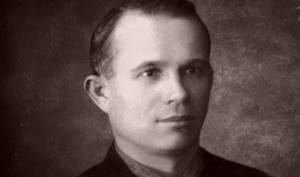
At the age of 18, Khrushchev worked as a mechanic in a coal mine.
Khrushchev is jokingly called the first Soviet biker. Having once seen a photograph of a motorcycle in his boss’s office, he welded his own iron horse from scraps of bicycle pipes and assembled the motor himself. The resulting vehicle remained on the road for 20 years and made Nikita the life of the party among local youth. At the same time, he never drank or smoked - his mother saved him from addictions.
At the age of 24, as soon as the revolution died down, Khrushchev joined the Communist Party. At the beginning of the Civil War, the young communist fled from Ukraine, fearing reprisals as a “Muscovite,” moved to Kalinovka to live with his grandfather, and then was drafted into the Red Army. He was a detachment commander, a battalion political commissar in the battles for the city of Tsaritsyn, and an instructor in the political department of the 9th Kuban Army.
After the war, he returned to the Rudchenkovo mine and from 1922 to 1925 he studied at the workers' faculty of the Don Technical School, where he was elected party secretary.
Description of the coat of arms
The shield is divided into two parts perpendicularly and from the middle of the shield to the lower corners by two diagonal lines, of which on the right side in a blue field two gold Crosses are depicted and between them a silver Horseshoe (Polish coat of arms Lubich). On the left side, in a red field, is a silver Arrow flying upward, accompanied on the sides by two golden hexagonal Stars, above this Arrow is visible a golden Crescent with its horns facing downwards (modified Polish coat of arms Sas). In the lower part, in a golden field, is a Lion with a silver arrow coming out of a red Wall.
The shield is topped with an ordinary noble helmet with a noble crown on it and three ostrich feathers. The border on the shield is blue and red, lined with gold. The coat of arms of the Khrushchev family is included in Part 2 of the General Arms of Arms of the Noble Families of the All-Russian Empire, p. 111.
Career in the CPSU
An proactive and assertive fighter for Stalin’s cause in 1925, he headed the Petrovo-Maryinsky district committee of the Communist Party of Ukraine (Bolsheviks) in the Donbass. In 1928, he received his first high appointment - deputy head of the organizational department of the Central Committee of the Communist Party - and moved to Kharkov, where the republican government bodies were located.
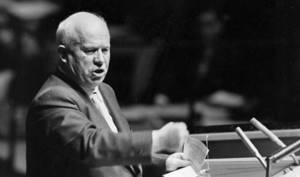
An initiative and assertive fighter for the cause of Stalin
A year later, he became a student at the Industrial Academy in Moscow, enthusiastically took up the fight against the “right” there and soon became the party secretary of the educational institution. In 1932, he was approved as the second secretary of the city committee. He became the right hand of the first person of the committee, a close associate of Stalin, Lazar Koganovich. In 1934, he was already the successor to his boss as head of the Moscow State Committee, and a year later - the regional committee, although he never received a diploma from the academy.
On behalf of Koganovich, the loyal Stalinist controlled the progress of metro construction. In 1935, in honor of the successful completion of the first stage of an important facility, he was awarded his first Order of Lenin. During the same period, he demonstrated considerable zeal in organizing Stalin’s “purges” and in implementing plans to accelerate the pace of industrialization. By 1937, the politician entered the circle of the most influential people in the USSR. He was a deputy of the Supreme Council, a member of the Presidium and the first secretary of the Central Committee of the Communist Party of Ukraine.
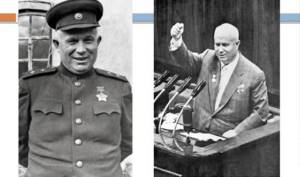
In 1935, Khrushchev was awarded his first Order of Lenin
Arriving in 1938 in Ukraine, which had experienced a terrible famine, and replacing the repressed Stanislav Kosior in the highest position, he began to form a new administrative apparatus of the republic to replace the one destroyed by mass repressions. Punitive expulsions did not stop under him, but were carried out on a lesser scale. The most striking moments from Khrushchev's speeches During the Second World War, the politician was a member of the military councils of a number of fronts. In 1943, he earned the high rank of lieutenant general. A year later, on the 50th anniversary of his birth, he was awarded the second Order of Lenin. He led the brutal suppression of the anti-Soviet partisan movement in the western regions of Ukraine, shooting more than 150 thousand and deporting about 200 thousand people out of the 3.5 million inhabitants of the region. He was the Prime Minister of the Ukrainian SSR, then the newly elected party secretary of the republic. As a member of the Politburo, he often visited the capital and met with the leader of the state.
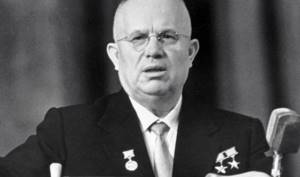
Nikita Khrushchev - Prime Minister of the Ukrainian SSR
Since 1949, the Ukrainian leader was transferred to Moscow. The head of the USSR instructed him to restore order in the capital's party organization and entrusted him with the post of secretary of the CPSU (b), although he did not have much respect for him. For example, during feasts at the leader’s dacha, where the most important issues of the state were discussed in a narrow circle, Joseph Vissarionovich forced his bald, short and overweight comrade-in-arms to dance the hopaka, bursting into laughter.
General Secretary of the CPSU Central Committee
Nevertheless, after Stalin passed away in 1953, the politician, whom many perceived as a poorly educated simpleton, managed to beat the all-powerful head of the special services Lavrenty Beria, Chairman of the Council of Ministers Grigory Malenkov and all other contenders in the fight for the throne, becoming the new sole party leader.
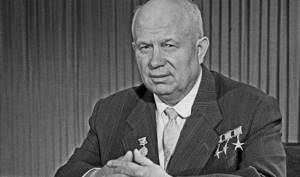
In 1953, Khrushchev took Stalin's place
During the years of being at the top of the political Olympus, Khrushchev did not build communism, as he promised, but he saved the country from many years of fear, rehabilitated more than 20 million people (though many of them posthumously), actively supported the development of science and technology, organizing the launch of the world's first nuclear power plant located in the Kaluga region, the first satellite and astronaut.
Among his successes in the agricultural sector are the lifting of the ban on collective farmers changing their place of residence, issuing them passports, cash wages, and the development of virgin lands. The positive results of his management also include the construction of free housing, the adoption of the “Peace Program,” cultural exchange with foreign countries, and a reduction of the army by a third.
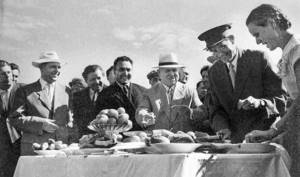
Khrushchev and collective farmers
However, he often acted inconsistently and too emotionally. For example, due to the ill-conceived military reform, many officers were left without housing and work, and the villagers, who under Stalin received 7 centners of grain as payment, began to receive money, but equivalent to only 3.7 centners. Collective farmers began to flee to the cities, and a shortage of bread arose. The country had to allocate 860 tons of gold to purchase grain from capitalist countries. Prices on the market increased by 13-17%, whereas under Stalin, prices traditionally decreased on April 1 of each year. Nikita Khrushchev's speech to the UN (1960) By 1964, the average annual economic growth rate had fallen from 11 to 5 percent. Due to the reduction in the number of collective farmers and low labor productivity, shortages in bread began; residents of the middle zone were forced to travel to the capital for food. At the same time, the USSR's gratuitous assistance to developing countries reached 3.5 billion rubles: India, Iraq, Syria, Ethiopia.
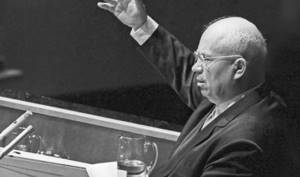
Nikita Khrushchev at a speech
The big disadvantage of his activities was the destruction of individual farms (the number of livestock was halved, personal plots were reduced to 15-25 acres), the “corn madness”, the disappearance of white bread from stores, the intensification of the “Cold War”, the “Carribean crisis”, the cessation of payments for “Stalinist” bonds, an increase in retail prices, which provoked mass unrest, including the tragedy in Novocherkassk.
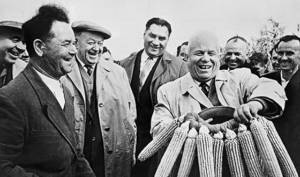
"Corn Madness" by Nikita Khrushchev
Khrushchev's policies led to the division of socialist countries into three blocs. Three “leaders” stood out: the USSR, Romania with Yugoslavia and China. Relations with the latter were spoiled after Khrushchev called Mao Zedong an “old galosh.”
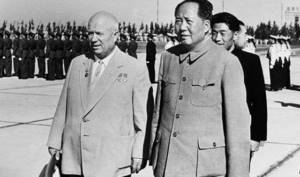
Nikita Khrushchev and Mao Zedong
Trying to create the image of a “peacemaker,” Khrushchev acted illogically: he brutally dispersed a rally in support of Stalin in Georgia, and no less brutally suppressed the uprising in Hungary in 1956. In 1957, he stopped payments on “Stalinist” bonds, which led to a 30% increase in prices for meat and dairy products. This led to popular unrest; in 1962, machine gun fire was opened on participants in a rally in Novocherkassk.
Another “invention” of Khrushchev is the famous five-story panel buildings. At one time, the Secretary General dispersed the USSR Academy of Architecture because they did not share Khrushchev’s opinion on the economic feasibility of building five-story buildings. In fact, with the money allocated for one “Khrushchev”, it was possible to build two 9-story buildings, saving on infrastructure - the costs of water supply and sewerage in 5-story buildings were higher.
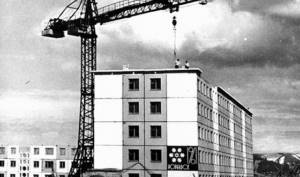
Panel five-story buildings - the famous “invention” of Khrushchev
Against the backdrop of many miscalculations, which led, instead of the promised abundance, to the threat of famine in the country, in 1964, the fighter against the cult of personality was removed from all positions at the October Plenum of the Central Committee. According to rumors, he said goodbye to his colleagues that the possibility of changing leadership without bloodshed was his main achievement. Khrushchev's successor was Leonid Brezhnev.
The onset of the thaw
The reign of Khrushchev marked a new socio-cultural turn in the life of the country. Creative people received, in a sense, greater freedom, theaters began to open, new magazines began to be published. In the USSR, artistic art, uncharacteristic of the existing socialist regime, began to develop, and exhibitions began to appear.
The changes affected freedom in the country in general. Political prisoners began to be released, leaving behind the era of brutal repressions and executions.
At the same time, one can also note the increased oppression of the Orthodox Church by the state and the apparatus control over the creative life of the intelligentsia. There were arrests and persecution of objectionable writers. Thus, Pasternak had to fully face them for the novel “Doctor Zhivago” he wrote. Arrests for “anti-Soviet activities” also continued.
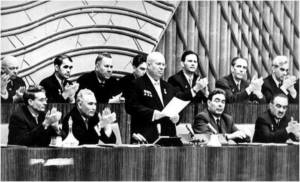
Personal life of Nikita Khrushchev
Khrushchev was married three times. His first chosen one was Efrosinya Pisareva, the sister of his fellow miner, whom he married before the revolution. In those years, Nikita Sergeevich, who received 40-50 rubles in gold per month, was provided with a government apartment and was exempt from military service as a highly qualified specialist, was known as an enviable groom.
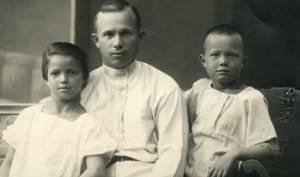
Nikita Khrushchev with children from his first marriage
She died of typhus in 1919 while her husband was fighting at the front, and left her 25-year-old husband with her 3-year-old daughter Yulia and 2-year-old son Lenya in her arms.
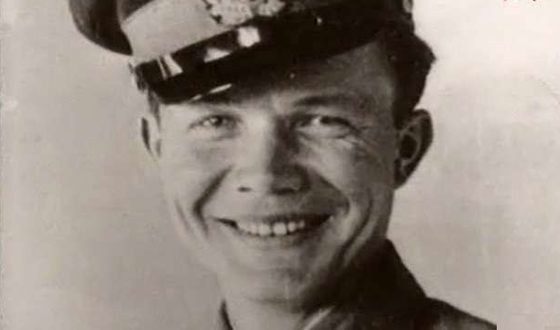
Nikita Khrushchev's son from his first marriage - Leonid
In 1922, Khrushchev became involved with Maria, a woman with a child from a previous marriage, but their relationship lasted little more than a year.
The third wife of the political leader and faithful life partner for 47 years was Nina Kukharchuk (born 1900), a teacher at the Yuzovsky party school, where they met and began living as a family in 1924.
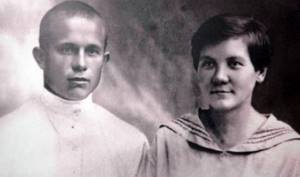
Nikita Khrushchev and Nina Kukharchuk
As the first lady, an educated woman who, in addition to Russian and Ukrainian, also spoke Polish, English and French, was well versed in economic issues, adequately represented the country during her husband’s trips abroad, surprising the contrast between her rustic appearance, plump figure and relaxed communication with representatives Western elite without a translator.
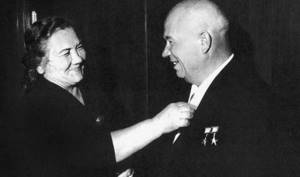
Nina Kukharchuk adequately represented the country on her husband’s trips abroad
They officially registered their marriage only after Nikita Sergeevich retired. In addition to two children from his first marriage, they raised three children together: daughters Radu and Elena and son Sergei.
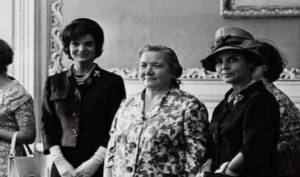
In the photo: Nina Khrushcheva and Jacqueline Kennedy
The politician loved cinema, theater, folk and classical music. His favorite songs were Ukrainian songs performed by Ivan Kozlovsky, “I Amazing at the Sky” and “Black Eyebrows, Brown Eyes.”
Heraldry
The Khrushchev coat of arms is one of the early Russian coats of arms. In May - June 1686, the Khrushchevs submitted to the Ambassadorial Order for translation into Russian the “certified sheet” of the Polish ambassadors about the Khrushchev nobility, at the same time they asked to write out about their origin from the “Orbis Polonus”. The Chamber of Genealogical Affairs also on June 15, 1686 addressed the Ambassadorial Prikaz with a request for an extract from the Polish chronicles and armorial books about the Khrushchevs. In September 1686, an extract from “Orbis Polonus” was sent to her and was used as evidence justifying the family’s right to be included in the genealogical book.
In the response sent by the Ambassadorial Order, the Khrushchev coat of arms was described as: “.... a salamander sitting on a fire, a fierce animal with outstretched wings, a peacock’s tail is written on the crown, and it is used as a symbol in wars of courage and courage, which is between fiery sulfur fires and military outfits showed the essence of the fact that in the military ascent between the stone mountains and the hard, inconvenient rapids of poisonous snakes full of scorpia, he lit a fire and killed the Khrushchevs near his camp at night.”
Coat of arms of the Khrushchevs granted estates in 1622.
The highest approved coat of arms of the Khrushchevs (OG. II. 111), granted estates in 1622 and other years, represents the emblems located in the fields:
- In a blue field there is a silver horseshoe with spikes towards the bottom, in the horseshoe and under the horseshoe along a golden clawed cross. The figure placed in the first part of this shield represents the Polish coat of arms of Lubicz.
- In a red field there is a silver arrow with its point up, on its sides there are two golden hexagonal stars, and above it is a golden moon with its horns down. The figures placed in the second part of the coat of arms represent the Polish coat of arms of Garczynsky.
- In a golden field, a lion emerges from behind a red wall with a silver arrow in its paws. The figure placed in the third part of the shield is a slightly modified Polish coat of arms of Prawdzic.
Coat of arms of the descendants of Pyotr Vasilyevich Khrushchev 1911.
The coat of arms of the descendants of Pyotr Vasilyevich Khrushchov was approved by the Supreme on March 11, 1911 and is: in a silver field, in a flame, a black salamander facing to the right. Peacock's tail crest. Shield holders: two lions. Motto: “Strength and courage.” This coat of arms is the Polish coat of arms Salamandra (Salamander).
Last years and death
After his resignation, the disgraced leader became a personal pensioner and lived in a dacha near Moscow, walking in the company of a shepherd named Arbat and the rook Kava (who fell out of the nest, fed by Khrushchev and became tame). The former general secretary communicated with security officers, talked with vacationers from a neighboring holiday home, and recorded his memories on a tape recorder (he was denied a stenographer to record his memoirs at the Central Committee).
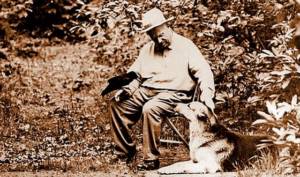
Former Secretary General of the USSR with pets
Later he became interested in photography and gardening. In the evenings, I often listened to broadcasts from Western radio stations “Liberty”, “Voice of America”, and the BBC, then expressing my opinion on the events taking place. He treated Academician Sakharov with sympathy, was sincerely indignant about attempts to rehabilitate Stalin, and was immensely shocked by Svetlana Alliluyeva’s flight from the country. It happened that he fell into depression, talked about the meaninglessness of his life, but then again, with a constant smile, he joked, walked, and told stories.
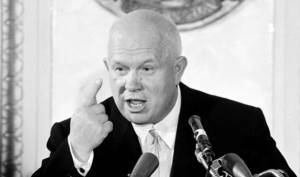
Khrushchev spent his last years at a dacha near Moscow.
In 1970, Khrushchev’s health deteriorated and he suffered his first heart attack. A year later, he died in hospital from a massive myocardial infarction. The former head of the USSR was buried at the Novodevichy cemetery. The monument at his grave was sculpted by Ernst Neizvestny from white and black marble - as a symbol of the contradictory contribution of Nikita Khrushchev to the history of the country.
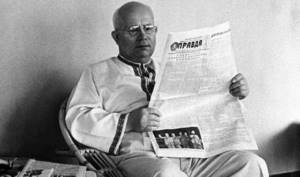
In 1971, Nikita Sergeevich Khrushchev passed away
The meaning of the surname Petrov
From the derivative forms of the name Peter (in Greek, stone, which at all times after the adoption of Christianity was one of the most common among the Slavs. Penkov is unlikely from the word penk, a small stump. Rather, from Penko, one of the diminutive forms of the name Peter. Petrov. Patronymic from the name Petr. The surname is one of the most common in Russia (in some territories up to people per thousand) N.V. Birilo counted the Belarusian forms of the name Petr. Petrishchev, reader Petrishchev, suggests that her surname could be formed from the name Peter big Peter, like a cockroach cockroach, house house, ashes ashes But she did not take into account that the suffix -ishch (e) not only expresses an increase, but also indicates the place of something, for example: a fortified settlement is not only a large city but also traces of a former city, an axe, not only a large ax but also ax handle In the past, it was customary to add the suffix -k-(a) to the names of all subordinates, which gave the name a derogatory meaning, and for priests they used -ish(e) as priest Ivanishche. Apparently, the name Petrishche was formed on this principle, the patronymic from which became the surname (like Ivanishchev, Pavlishchev, Fedorishchev and others. Petrov surnames with the ending -i(y) are typical for the northern regions and from there they spread to Siberia with settlers. Petrosov, re-formatted by the suffix -ov, which is prevalent in Russian surnames, the Armenian surname Petrosyan from Petros with the suffix -yan (from -yants) is identical to the Russian Petrov. Petrovsky, Petrikovsky most likely from the geographical name Petrovo, Petrikovo, etc. Petrovichev is a middle name of the second order. Petrovich is Peter’s son, and Petrovichev is Petrovich’s son and is already Peter’s grandson. Petruchenya is a Belarusian surname.
Origin of the Petrov surname: Russian surnames.
For each surname, the degree of compatibility with other surnames can be calculated.
The compatibility of surnames allows you to determine how much these surnames, due to their features and characteristics, allow you to build communicative, friendly, and loving relationships between people.
A surname is like a mirror of a person - it reflects his character and destiny. And the desire of any person to surround himself with like-minded people with whom you feel at ease, with whom you feel calm and reliable is understandable. On the contrary, the struggle of characters, confrontation of temperaments lead to disputes, discord and conflicts.
Share the link “Compatibility of the surnames Khrushchev and Petrov” with friends on social networks:
